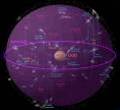Credit: NASA/ESA
eLISA
(Proposal)
eLISA (the Evolved Laser Interferometer Space Antenna), is a proposed space based detector using three spacecraft arranged in an equilateral triangle. The original LISA experiment was a joint proposal between NASA and the ESA, but NASA has dropped out leaving the ESA to fund the experiment. The LISA proposal included arms 5 million kilometers long, while eLISA has reduced this to one million kilometers. Due to the much longer "arm length", LISA is sensitive to waves of much lower frequency than LIGO. This allows it to detect, for example:
LIGO
Experiments
•
the gravitational waves produced by binary pairs of black holes and other compact objects when they merge
•
the merger of the supermassive black holes at the center of two merging galaxies
•
from exotic, hypothetical objects like cosmic strings and other phase transitions
•
possibly even gravity waves from the very early stages of the Big Bang itself.
VIRGO
VIRGO is a joint French/Italian gravitational wave detector located in Italy. Conceptually similar to LIGO, it is a little smaller with arms 3 km (2 miles) long with effective lengths of up to 120 km (75 miles). The apparatus started operations in May 2007. An advanced version of VIRGO went through engineering trials in May 2017 to produce improvements similar to advanced LIGO. The VIRGO project will soon join with LIGO to produce significantly better localization of the sources of the waves.
GEO600
GEO600 is a much smaller Anglo/German project with detector arms 600 meters (1,950 feet) long.
TAMA300
TAMA300 is a Japanese gravitational wave detector. Similar to, but smaller than, GEO600, it utilizes arms that are 300 meters (975 feet) long, and has been in operation since 1999.
Physics
-
Gravity
It is planned for launch in 2034, but this date is tentative. A non-technical description of the original LISA proposal is available at Evie Marom's Blog. I also suggest following her on Twitter; very interesting with some great photography. You can also follow the latest eLISA news at the eLISA website.
History
LIGO, the Laser Interferometer Gravitational-Wave Observatory, comprises a pair of "L" shaped detectors with
arms 4 kilometers (about 2½ miles) long; LIGO Livingston in Louisiana and LIGO Hanford on the Hanford Nuclear
Reservation. They are 3,002 kilometers (1,865 miles) apart. The laser beam travels up and down the arms up to
75 times giving an effective length of up to 300 km (nearly 190 miles). It has been in operation since 2002, but
has yet to report a confirmed detection of any gravity waves.
The mirrors within the system are so well protected from outside interference that the random vibrations of the
atoms in the mirrors is detectable. To be successful, LIGO must measure a change in the distance between the
mirrors as small as one thousandth the diameter of a proton; that is, down to 10-18 meters. The whole system is
contained in a vacuum so rarified it is at approximately one-trillionth of an atmosphere. At the same time, the
vacuum container has a volume of about 28,000 cubic meters (almost 300,000 cubic feet).
Enhanced LIGO went on-line in 2009, and Advanced LIGO, with around ten times the sensitivity, first went fully on-
line in September 2015. It has the capability of looking much further into the Universe, increasing the number of
sources in its range by a factor of 1,000, as shown in the diagram above to the right. The original LIGO
experiments shut down at the end of 2010 to allow the upgrade to Advanced LIGO.
On 17, February 2016, the Indian Government approved construction of a third Ligo array in India. Planned
completion is end 2023.
Detections
On 11 February, 2016, the LIGO team announced that they had detected gravitational waves from the merging of
two black holes with masses of around 29 and 36 solar masses. The event occurred about 1.3 billion light years
away, and was recorded on September 14th 2015. Two black holes of masses approximately 36 and 29 solar
masses merged to produce a single black hole of 62 solar masses with the equivalent of three solar masses
radiated as gravitational waves.
A second detection occurred on 26 December 2015 about 1.4 billion light years away. The black holes were of
significantly lower mass; 14 and 8 solar masses, and resulted in a 21 solar mass black hole with one solar mass
radiated.
The third detection on 4 January 2017 was about 3 billion light years away; significantly further than the first two
detections. The masses involved were intermediate to the first two resulting in a 49 solar mass black hole.
Menu:




